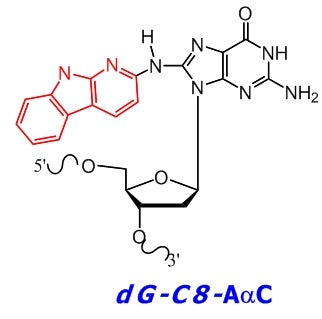Many aromatic amines are environmental toxins and human carcinogens. They damage genome and form different bulky DNA lesions, which give rise to different mutation patterns. This application will study the mutational spectra of bulky DNA lesions generated from aromatic amine exposure and provide insights into the development of tumors.
Project Summary
Many environmental toxins damage DNA and cause diseases. The exposure of cells with DNA damaging agents results in the formation of a host of different DNA lesions, a subset of which can give rise to mutations. If one were to plot the frequency and type of mutation as a function of the position along a gene, a distribution is generated that is commonly referred to as a mutational spectrum. It is reasonable to speculate that mutational hotspots are modulated by the local sequence environment surrounding the base to be modified, or the DNA lesion to be repaired or replicated. It is important for environmental scientists to provide insights into the evolutionary changes that foreshadow tumor development before overt clinical symptoms appear. This goal is crucial because some diseases, such as tumors, show few clinical symptoms until the disease has reached a late, usually fatal stage. Early onset genomic biomarkers might enable intervention to eliminate or curtail development of the disease. The biomarkers of a disease caused by a specific toxin can be obtained by studying the mutational spectra of DNA lesions generated from the toxin. Experimental studies of the mutations and mutation spectra induced by environmental toxins have traditionally focused on single mutations. However, the origins of mutational hotspots is complicated by the neighboring contexts. The selective formation, replication, and repair of a DNA lesion can, in principle, be influenced by the surrounding nucleotide environment from both 5’ and 3’ ends. A nearest-neighbor analysis of a certain DNA lesion (NXN, X = lesion, N = one of the four nucleotides) will provide a structural rationale for mutational spectra in environmental toxin related human tumors. In this proposal, we will study individual lesions of environmental toxins under all the genetic and epigenetic relevant contexts. In this project, we select two important environmental toxins, 4-amino biphenyl (ABP) and amino alpha carboline (AaC) to study the mutational spectra of their major DNA lesions and correlate with mutational signatures of diseases caused by them. The central hypothesis of this project is that DNA lesions generated by environmental toxins will cause different mutational spectra in a sequence dependent manner. The Specific Aims are: Specific Aim 1: Chemical synthesis and identification of bulky DNA adduct containing oligonucleotides. Specific Aim 2: Mutational spectra of bulky lesions in cell. Specific Aim 3: Replication bypass of lesions by translesion synthesis polymerases. At the conclusion of this project we will have demonstrated how the interaction between environmental toxins and mutational spectra. These studies shall utilize in a combination of genetic, chemical, and spectroscopic tools to understand and manipulate biological systems at the molecular level.

